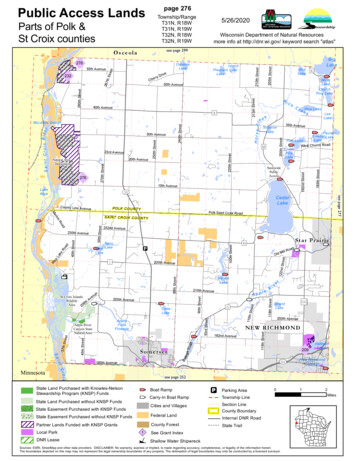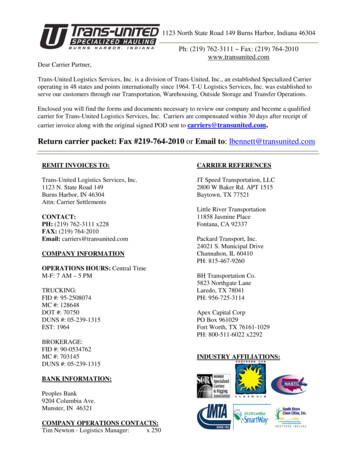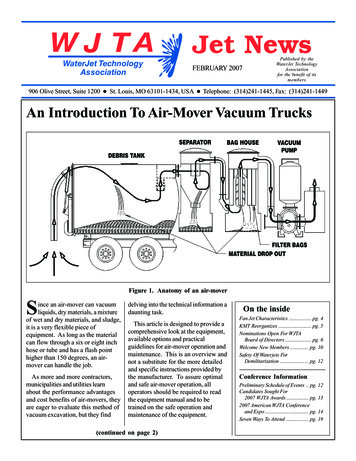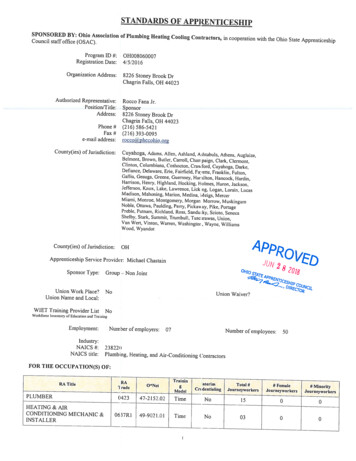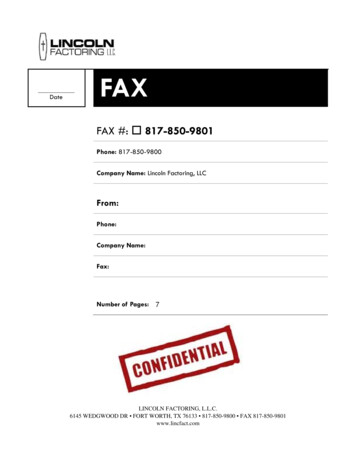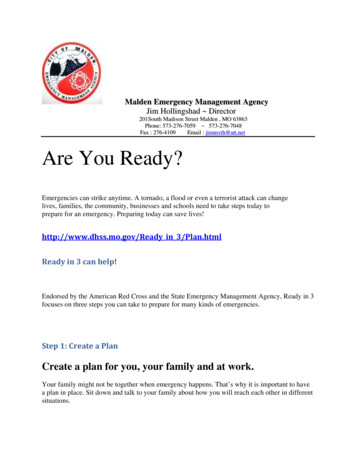
Transcription
Malden Emergency Management AgencyJim Hollingshad Director201South Madison Street Malden , MO 63863Phone: 573-276-7059 573-276-7048Fax : 276-4109Email : jimmyth@att.netAre You Ready?Emergencies can strike anytime. A tornado, a flood or even a terrorist attack can changelives, families, the community, businesses and schools need to take steps today toprepare for an emergency. Preparing today can save lives!http://www.dhss.mo.gov/Ready in 3/Plan.htmlReady in 3 can help!Endorsed by the American Red Cross and the State Emergency Management Agency, Ready in 3focuses on three steps you can take to prepare for many kinds of emergencies.Step 1: Create a PlanCreate a plan for you, your family and at work.Your family might not be together when emergency happens. That’s why it is important to havea plan in place. Sit down and talk to your family about how you will reach each other in differentsituations.
Make sure everyone in the family can get to a safe place and find each other in the event of anemergency. For instance, it is a great idea todesignate two family meeting places, one in theneighborhood and one farther away.Consider contacting the same friend or familymember by telephone or e-mail. Think aboutmaking an out-of-town family member or friendthe contact. It might be easier to make a longdistance telephone call instead of a local callduring an emergency. It could be easier for an outof-town person to connect separated familymembers.You should plan for two situations – staying homeor leaving. Deciding whether it is best to stay or go depends on the type of emergency. Officialsmay tell you what you need to do. In some cases, limited communication and information mayrequire you to decide what is best for you and your family.Know where to go if you have to leave. Sometimes it may not be safe to stay in your home. Planwhere your family can meet. Know where you will go and how you will get there if you have toleave your home.Family Plans are available in English, Spanish, and Bosnian and outline the items that should beincluded in your emergency plan.Emergency Preparations for Individuals with Special Needs & SeniorsEmergency Preparations for Children in SchoolsStep 2: Prepare a KitPrepare a kit for your home, car and at work.For Your Home:During an emergency, you may not be able to get food or water for days or weeks, and yourelectricity may not be working. The followingitems should be part of your emergency kit andkept in a container that can be easily carried if youneed to leave home: Water - families should set aside one gallon ofwater per person per day, to last 14 days.
Canned or dried food - families should set aside a 14-days supply of food per person. The foodshould be nonperishable items that don’t need to be cooked, such as tuna and crackers.Remember to include a manual can opener. If there’s an infant in the house, include formulaand baby food.Battery-powered radioFlashlightExtra batteries for the radio and flashlightList of prescription medicationsFirst-aid kitTips: For power outages, consider adding a corded telephone to your emergency kit if you are usingonly cordless telephones in your home currently.Learn how to use text messaging on your cell phone, most text messages will be sent even whenyou do not have cellular signal to make a call.Never use a generator indoors and install carbon monoxide detectors throughout your home.For Your Car:Keep a small, portable emergency supply kit in your car at all times. You should include a gallonof water, several cans of food, a manual can opener, blankets, sleeping bags, money, and first-aidsupplies.At Work:Keep your own supply of fresh water and canned food, a flashlight, and battery-powered radio atyour desk or in your locker. Everyone should consider keeping a change of clothes, and a pair ofstrong, practical shoes or boots at work.For Your Pets:Make sure your pets have identification tags and up-to-date vaccinations. If you must leavehome, bring your pet with you, if possible. You can plan ahead by creating a supply kit for yourpet that includes extra food, water and medications. A carrier and leash will also be important.For cats, remember to include extra litter.
Step 3: Listen for InformationListen for information about what to do and where to goduring an actual emergency.It is important to stay calm in an emergency. Get as much information about the situation aspossible. If there is no electricity, make sure to have a battery-powered radio with extra batteriesso you can listen for updates and instructions.City, county, and state officials have developed emergency plans. In the event of an actualemergency, it’s important to follow their instructions and advice. They will provide you with thelatest information.If you are like thousands of Missourians, your pet is an important member of your household.The likelihood that you and your animals will experience an emergency such as a fire, flood,tornado, or power outage is great; but preparing today will help decrease the stress on your entirehousehold later. Some of the things you can do to prepare for the unexpected, such as assemblingan animal emergency supply kit and developing a pet care buddy system are the same for anyemergency. Whether you stay at home during an emergency or must evacuate to a safer location,you will need to make plans in advance for your pets. Keep in mind that what's best for you istypically what's best for your animals.If you must evacuate, take your pets with you if possible. However, if you are going to a publicshelter, it is important to understand that animals may not be allowed inside. Plan in advance forshelter alternatives that will work for both you and your pets. Service animals who assist peoplewith disabilities are the only animals allowed in most shelters (as required by law).Make a back-up emergency plan in case you can't care for your animals yourself. Develop abuddy system with neighbors, friends and relatives to make sure that someone is available to carefor or evacuate your pets if you are unable to do so.If you have no alternative but to leave your pet at home, there are some precautions you musttake, but remember that leaving your pet at home alone can place your animal in great danger!Confine your pet to a safe area inside - NEVER leave your pet chained outside or confined to acrate! Leave them loose inside your home with food and plenty of water. Make allowances, ifyou can, for heat and ventilation issues your pet may face in your absence. Prepare as if you willnot be able to return home for 7-10 days. For larger dogs, you can remove the toilet tank lid,raise the seat or fill the bathtub with water and brace the bathroom door open so they can drink.
Place notices outside in a visible area, advising what pets are in the house and where they arelocated. Provide a telephone number where you or a contact can be reached as well as the nameand number of your veterinarian.Whether you are away from home for a day or week, you’ll need essential supplies. Keep itemsin an accessible place and store them in sturdy containers that can be easily carried. Use theEmergency Preparedness Checklist for Pet Owners as you prepare your pets for emergenciessituations.Related Links:Humane Society of MissouriMissouri Veterinary Medical AssociationMissouri Veterinary Medical Boardtornadoes.Tornado!Although tornadoes occur in many parts of the world, thesedestructive forces of nature are found most frequently in the United States east of the RockyMountains during the spring and summer months. In an average year, 800 tornadoes arereported nationwide, resulting in 80 deaths and over 1,500 injuries. A tornado is defined as aviolently rotating column of air extending from a thunderstorm to the ground. The most violenttornadoes are capable of tremendous destruction with wind speeds of 250 mph or more.Damage paths can be in excess of one mile wide and 50 miles long. Once a tornado in BrokenBow, Oklahoma, carried a motel sign 30 miles and dropped it in Arkansas!
What causes tornadoes?Thunderstorms develop in warm, moist air in advance of eastward-moving cold fronts. Thesethunderstorms often produce large hail, strong winds, and tornadoes. Tornadoes in the winter andearly spring are often associated with strong, frontal systems that form in the Central States andmove east. Occasionally, large outbreaks of tornadoes occur with this type of weather pattern.Several states may be affected by numerous severe thunderstorms and tornadoes.During the spring in the Central Plains, thunderstorms frequently develop along a "dryline,"which separates very warm, moist air to the east from hot, dry air to the west. Tornado-producingthunderstorms may form as the dryline moves east during the afternoon hours.Along the front range of the Rocky Mountains, in the Texas panhandle, and in the southern HighPlains, thunderstorms frequently form as air near the ground flows "upslope" toward higherterrain. If other favorable conditions exist, these thunderstorms can produce tornadoes.Tornadoes occasionally accompany tropical storms and hurricanes that move over land.Tornadoes are most common to the right and ahead of the path of the storm center as it comesonshore.Tornado Variations Some tornadoes may form during the early stages of rapidly developing thunderstorms. Thistype of tornado is most common along the front range of the Rocky Mountains, the Plains, andthe Western States.Tornadoes may appear nearly transparent until dust and debris are picked up.Occasionally, two or more tornadoes may occur at the same time.How Do Tornadoes Form?Before thunderstormsdevelop, a change in winddirection and an increase inwind speed with increasingheight creates an invisible,horizontal spinning effect inthe lower atmosphere.Rising air within thethunderstorm updraft tilts therotating air from horizontal tovertical.An area of rotation, 2-6miles wide, now extendsthrough much of the storm.Most strong and violenttornadoes form within thisarea of strong rotation.
Woodward OK (Ron Przybylinski)A lower cloud base in thecenter of the photographidentifies an area of rotationknown as a rotating wallcloud. This area is oftennearly rain-free. Note rain inthe background.Woodward OK (Ron Przybylinski)Moments later a strongtornado develops in this area.Softball-size hail anddamaging "straight-line"winds also occurred with thisstorm.
Tornadoes Take Many Shapes and SizesWeak Tornadoes 69% of all tornadoesLess than 5% of tornado deathsLifetime 1-10 minutesWinds less than 110 mphStrong Tornadoes 29% of all tornadoesNearly 30% of all tornado deathsMay last 20 minutes or longerWinds 110-205 mphTornado Myths:MYTH: Areas near rivers, lakes, and mountains are safe from tornadoes.FACT: No place is safe from tornadoes. In the late 1980's, a tornado swept through YellowstoneNational Park leaving a path of destruction up and down a 10,000 ft. mountain.MYTH: The low pressure with a tornado causes buildings to "explode" as the tornado passesoverhead.FACT: Violent winds and debris slamming into buildings cause most structural damage.MYTH: Windows should be opened before a tornado approaches to equalize pressure andminimize damage.FACT: Opening windows allows damaging winds to enter the structure. Leave the windowsalone; instead, immediately go to a safe place
Frequency of TornadoesTornadoes can occur at any time of the year. In the southern states, peak tornado occurrence is in March through May, while peakmonths in the northern states are during the summer.Note, in some states, a secondary tornado maximum occurs in the fall.Tornadoes are most likely to occur between 3 and 9 p.m. but have been known to occurat all hours of the day or night.The average tornado moves from southwest to northeast, but tornadoes have beenknown to move in any direction. The average forward speed is 30 mph but may varyfrom nearly stationary to 70 mph.The total number of tornadoes is probably higher than indicated in the western states.Sparce population reduces the number reported.STAY INFORMED ABOUT THE STORMby listening to NOAA Weather Radio, commercial radio, and television forthe latest tornado WATCHES and WARNINGS and the Malden EmergencyManagement Agency on your scanner at 155.760.When conditions are favorable for severe weather to develop, a severe thunderstorm or tornadoWATCH is issuedWeather Service personnel use information from weather radar, spotters, and other sources toissue severe thunderstorm and tornado WARNINGS for areas where severe weather is imminent.Severe thunderstorm warnings are passed to local radio and television stations and are broadcastover local NOAA Weather Radio stations serving the warned areas. These warnings are also
relayed to local emergency management and public safety officials who can activate localwarning systems to alert communities.NOAA WEATHER RADIO IS THE BEST MEANS TORECEIVE WARNINGS FROM THE NATIONAL WEATHERSERVICEThe National Weather Service continuously broadcasts updated weather warnings and forecaststhat can be received by NOAA Weather Radios sold in many stores. The average range is 40miles, depending on topography. Your National Weather Service recommends purchasing aradio that has both a battery backup and a tone-alert feature which automatically alerts you whena watch or warning is issued.What To Listen For. TORNADO WATCH: Tornadoes are possible in your area. Remain alert for approachingstorms.TORNADO WARNING: A tornado has been sighted or indicated by weather radar. If atornado warning is issued for your area and the sky becomes threatening, move to yourpre-designated place of safety.SEVERE THUNDERSTORM WATCH: Severe thunderstorms are possible in your area.SEVERE THUNDERSTORM WARNING: Severe thunderstorms are occurring.Remember, tornadoes occasionally develop in areas in which a severe thunderstormwatch or warning is in effect. Remain alert to signs of an approaching tornado and seekshelter if threatening conditions exist.Environmental CluesLook out for: Dark, often greenish skyWall cloud
Large hailLoud roar; similar to a freight trainCaution: Some tornadoes appear as a visible funnelextending only partially to the ground.Look for signs of debris below the visiblefunnel.Alma, NE (Gene Rhoden) Some tornadoes are clearly visiblewhile others are obscured by rain ornearby low-hanging clouds.Mike EmlawOther Thunderstorm HazardsCenter photo Bill BuntingThese dangers often accompany thunderstorms: Flash Floods: Number ONE weather killer - 146 deaths annuallyLightning: Kills 75-100 people each yearDamaging Straight-line Winds: Can reach 140 mphLarge Hail: Can reach the size of a grapefruit - causes several hundred million dollars in damageannually to property and cropsContact your local National Weather Service office, American Red Cross chapter, or FederalEmergency Management Agency office for a copy of the "Thunderstorms and Lightning.The
Underrated Killers" brochure (NOAA PA 92053) and the "Flash Floods and Floods.TheAwesome Power" brochure (NOAA PA 92050).Tornado SafetyWhat YOU Can DoBefore the Storm: Develop a plan for you and your family for home, work, school and when outdoors.Have frequent drills.Know the county/parish in which you live, and keep a highway map nearby to follow stormmovement from weather bulletins.Have a NOAA Weather Radio with a warning alarm tone and battery back-up to receivewarnings.Listen to radio and television and the Malden EMA on 155.760 on your scanner for information.If planning a trip outdoors, listen to the latest forecasts and take necessary action if threateningweather is possible.If a Warning is issued or if threatening weather approaches: In a home or building, move to a pre-designated shelter, such as a basement.If an underground shelter is not available, move to an interior room or hallway on the lowestfloor and get under a sturdy piece of furniture.Stay away from windows.Get out of automobiles.Do not try to outrun a tornado in your car; instead, leave it immediately.Mobile homes, even if tied down, offer little protection from tornadoes and should beabandoned.It's Up To YOU!Each year, many people are killed or seriously injured by tornadoes despite advance warning.Some did not hear the warning while others received the warning but did not believe a tornadowould actually affect them. The preparedness information in this brochure, combined with timelysevere weather watches and warnings, could save your life in the event a tornado threatens yourarea. After you have received the warning or observed threatening skies, YOU must make thedecision to seek shelter before the storm arrives. It could be the most important decision you willever make.
Who's Most At Risk? People in automobilesThe elderly, very young, and the physically or mentally impairedPeople in mobile homesPeople who may not understand the warning due to a language barrierTornado Safety in SchoolsEVERY School Should Have A Plan! Develop a severe weather action plan and have frequent drills,Each school should be inspected and tornado shelter areas designated by a registeredengineer or architect. Basements offer the best protection. Schools without basementsshould use interior rooms and hallways on the lowest floor and away from windows.Those responsible for activating the plan should monitor weather information fromNOAA Weather Radio and local radio/television.If the school's alarm system relies on electricity, have a compressed air horn ormegaphone to activate the alarm in case of power failure.Make special provisions for disabled students and those in portable classrooms.Make sure someone knows how to turn off electricity and gas in the event the school isdamaged.Keep children at school beyond regular hours if threatening weather is expected. Childrenare safer at school than in a bus or car. Students should not be sent home early if severeweather is approaching.Lunches or assemblies in large rooms should be delayed if severe weather is anticipated.Gymnasiums, cafeterias, and auditoriums offer no protection from tornado-strengthwinds.Move students quickly into interior rooms or hallways on the lowest floor. Have themassume the tornado protection position (shown at right).Nursing homes, and other institutions should develop a similarplanYour National Weather Service, Federal Emergency Management Agency, and American RedCross educate community officials and the public concerning the dangers posed by tornadoes.YOU can prepare for the possibility of a tornado by learning the safest places to seek shelterwhen at home, work, school, or outdoors. You should also understand basic weather terms and
danger signs related to tornadoes. Your chances of staying safe during a tornado are greater ifyou have a plan for you and your family, and practice the plan frequently.FAMILY DISASTER PLANFamilies should be prepared for all hazards that affect their area. NOAA's National WeatherService, the Federal Emergency Management Agency, and the American Red Cross urge eachfamily to develop a family disaster plan.Where will your family be when disaster strikes? They could be anywhere - at work, at school,or in the car. How will you find each other? Will you know if your children are safe? Disastersmay force you to evacuate your neighborhood or confine you to your home. What would you doif basic services - water, gas, electricity or telephones - were cut off?Follow these basic steps to develop a family disaster plan.1.I. Gather information about hazards.Malden EMA, and American Red Cross chapter. Find out what type of disasters could occur andhow Contact your local National Weather Service office, emergency management or civildefense should respond. Learn your community's warning signals and evacuation plans.2.II. Meet with your family to create a plan.Discuss the information you have gathered. Pick two places to meet: a spot outside your homefor a
Malden Emergency Management Agency Jim Hollingshad Director 201South Madison Street Malden , MO 63863 . water per person per day, to last 14 days. . An area of rotation, 2-6 miles wide, now e


